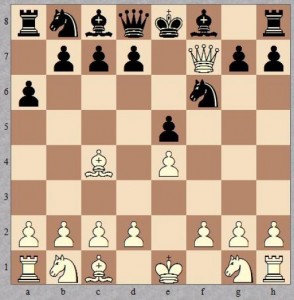Chess is not only a game of strategy, but also of risk. Players sometimes take chances in the hopes of either psyching out their opponent or pulling off a “hail mary” that has a limited chance of succeeding at great risk to them.
The four move checkmate (also known as Scholar’s Mate) is one of those hail mary plays that can score white an easy win should his or her opponent decide that they’d rather be thinking about Chip ‘n Dale: Rescue Rangers fan fiction.
If playing white, your goal is to get your queen to f3 or h5 and your king’s bishop to c4. These two pieces in conjunction are attacking the pawn on f7, which is only being protected by the enemy king. The game might look something like this…
1. e2-e4, e7-e5 2. f1-c4, a7-a6 3. d1-h5, g8-f6 4. h5-f7 mate.
If I’m playing white and want to try for scholar’s mate, I prefer to get my queen immediately to h5 and not move to f3. At h5, you have more options. You’re putting pressure on the pawn at e5 right away, forcing your enemy to react to that threat. If he doesn’t protect it or respond correctly, you can take it and put the enemy in check. The risk to white however is that if black responds correctly, he/she would have lost tempo being forced to retreat their queen.
Tempo, as simply as I can put it, is how quickly a player gets his pieces into position. Being forced to retreat pieces instead of further developing gives the other player time to advance their pieces and get into a better position. The player who wastes moves retreating or moving the same piece around constantly is said to be losing tempo and the player who continues to advance and develop is gaining tempo.
Playing black in this situation requires the player to respond exactly the correct way. For one, if your enemy moves their queen to h5 first, get your queen’s knight out to c6 to protect your pawn at e5. When he brings the bishop out, push your pawn forward at g7-g6, blocking the attack and making the queen move. After that, bring your other knight out to f6.
Note: Bringing the wrong knight out first will result in the queen being able to take the pawn at e5. Also, do not immediately try g7-g6 as the queen at h5 can take your pawn at e5 and fork your king and rook.
Practice this a few times, trying out different combinations and you’ll quickly see that the dreaded four move checkmate is not as bad as you think. In the right hands however and against the careless, it can be a deadly opening attack.
Click Here to return to the main article.
—

